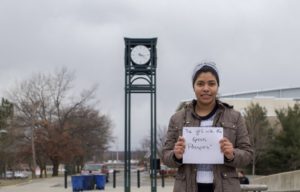Pakistani immigrant recalls struggle to assimilate
Julio Rodriguez
Creative Editor

“I feel like people look down on me because of my identity,” said business administration Zaish Sadiq about being not wearing Pakistani clothing after her move to the U.S.
Moving to the U.S. posed a challenge for Sadiq who is a newly inducted American. Sadiq found the move from Pakistan to the U.S to be fast paced, and discriminatory.
“All of the sudden we got this call from the embassy that we had our interview on Jan. 27, 2013, and we had to be there or we would not be considered for visas,” said Sadiq. “We applied ten years ago, and then we got our visas – It was very unexpected,” she said.
It was a long road before Sadiq’s family was allowed to leave Pakistan for the U.S. After their approval, Sadiq’s family had to uproot their lives and rush to the U.S.
“After the interview was done, we got our medical done in March, and we left on the 24th,” she said.
Sadiq was about to graduate high school and was one month away from finals before moving out of the country.
“Suddenly I couldn’t go to school anymore because we were moving,” said Sadiq.
Sadiq quickly became aware of her differences when she received unwanted looks and comments from strangers.
“I would not wear Pakistani clothes outside – even today I do not wear them,” she said. “It’s not that I’m embarrassed, it’s just that the way people look at you, it makes you feel like you don’t belong,” said Sadiq.
Sadiq experienced an unpleasant encounter when a man disagreed with her clothing choices at a YMCA sauna. Sadiq wore yoga pants in the sauna and was approached by a man who told her she wasn’t supposed to wear what she had on inside the sauna.
“IHe said, ‘What country are you from? Do you even belong here? This is not your country, and if you want to do this you should go back to where you belong,’” said Sadiq.
Sadiq was deeply hurt by the comments, but she’s made a discovery about herself and her culture in the process.
In her home country, women are told to stay quiet, but Sadiq discovered as an American she shouldn’t associate fear with standing up for herself.
“I experienced discrimination, and I didn’t stick up for myself,” said Sadiq. “It got stuck in my head that if you talk back, you’re being disrespectful [and] that’s changed with me since then,” she said.
Since her move from Pakistan, Sadiq has transformed in more ways than one. Now, Sadiq is unafraid and more willing to defend herself in the face of discrimination.
Sadiq believes the immigration ban put in place by president Trump neglects to recognize the immigrants that contribute to the country’s productivity.
“America is a land of immigrants. A lot of people have supported immigration to the U.S. I am one, and it’s disturbing to see that America put a ban on immigration. A lot of countries idolize this country, and they look up to it,” said Sadiq.
“The girl with the green passport has to stand in a different line to be processed,” said Sadiq.
Sadiq describes her journey to the U.S. as fearful. Sadiq was forced to stand in a line with other green passport holders. Her family had green passports, and the British had blue.
“Coming here was painful,” said Sadiq. “The way that people looked at us because of our green passports felt wrong [and] I didn’t know what was going on, but when I arrived in the U.S. I learned about what happened to me. It was discrimination,” she said.
Sadiq experienced racial discrimination for the first time, and she was shocked by the procedure to immigrate to the U.S.
“We went to Dubai [from Pakistan], and there was so much checking, I thought they were going to check my insides to see what I had to eat three weeks ago,” she said.
Sadiq grew up with the idea that those who did not go to university in Pakistan were less than those who had. As a result, the classroom setting was fraught with hostility. A certain degree of respect was expected of all students.
“The teachers in Pakistan were horrible,” said Sadiq. “They hit you, and it’s basically like being in boot camp from kindergarten to tenth grade,” she said.
Sadiq struggled to assimilate, and her experience at school was difficult.
“On the first day of school in America, I asked my teacher, ‘May I come in?’ She looked at me and said, ‘You’re already in, honey,’,” said Sadiq. “I got sick the first three days because I was so nervous [and] I didn’t know what to say to teachers,” said Sadiq.
Sadiq was finishing off high school in Pakistan, but she was just starting in the U.S.
“I started school in the states at 10th grade. It’s funny because I thought that the classes were going to be hard, but I took geometry in seventh grade. It was the same material I learned in Pakistan during seventh grade. Studies here are so easy if you’re smart, and from Pakistan. The only thing that put me back is that everything is in English,” said Sadiq.
Sadiq was ahead of the learning curve in certain aspects, but not others. Sadiq struggled in history because of the differences in curriculum taught.
“ I didn’t know about slavery [and] I had no idea that people who were not white were discriminated against,” said Sadiq. “I didn’t know what the word segregation or feminism meant,” she said.
Sadiq was quickly made aware of all of the ideals which had been hidden from her for years. As a result, she was exposed to a new thought process.
“I started realizing that just because I was a girl, that does not mean I was not able to pursue certain things,” said Sadiq.
